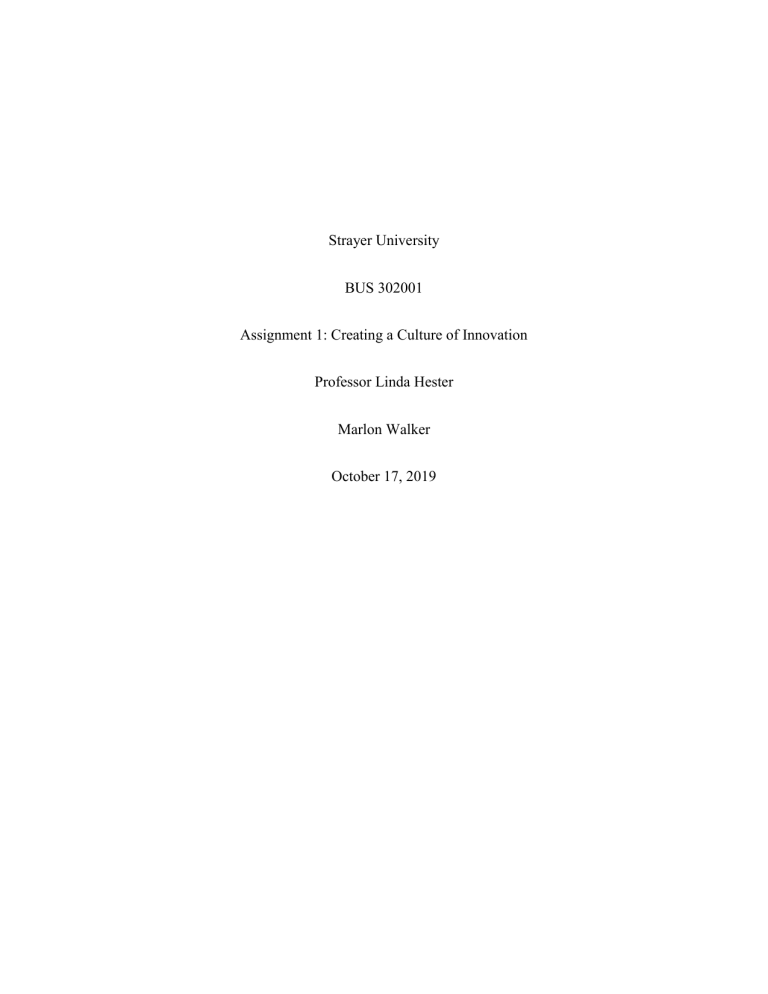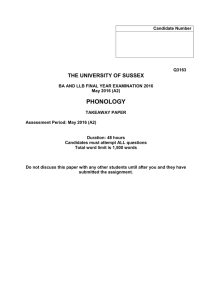
Strayer University BUS 302001 Assignment 1: Creating a Culture of Innovation Professor Linda Hester Marlon Walker October 17, 2019 This paper will examine how my new tech firm, ‘2KRoboware’, will attract and recruit highly motivated, tech-savvy employees to staff our company, providing high levels of growth, performance, and prosperity. I established 2kRoboware in 2018 with the expressed goal of developing cutting-edge robotics platforms which will aid manufacturing firms in their quest for increased output and a reduction in the human element in mass production. I anticipate the creation of an attractive company culture will be a tremendous draw in assisting our efforts to recruit the very best candidates for employment with our company. To that purpose, we have set what we consider to be the traits we considered most desirable in our prospective employees, namely: Being open minded- possessing the ability to accept/consider new ideas, not prejudiced by “what has been done before”. This attribute is a key element in a candidate’s potential for growth within our firm, as we are a ‘think outside the box’ company that needs associates who will do likewise. (1). Leadership- We will aggressively pursue those who exhibit true leadership qualities, such as grace under pressure, positivity about the company goals, and earning and giving respect to her/his teammates. We feel great leaders will enhance our company image and foster increased visibility and performance. Humility- This trait can go a long way towards ameliorating negativity that can crop up in any workplace environment. If we hire employees who are confident but not boastful, are keenly aware of their own accomplishments but not disdainful of others, then humility is properly ensconced in those individuals’ approach to the job. We all stand to gain from a climate where humility, not hubris, is the prevailing attitude. Expertise- Our firm considers expertise as absolutely essential in our valuation of any candidate’s potential for employment. “Set a high bar for quality. Before you start recruiting, decide what attributes you want and define as a group what great looks like. A good rule of thumb is to hire only people who are better than you. Do not compromise. Ever.” That’s what Laszlo Bock, Google’s SVP for People Operations, uses as a guiding principle for recruiting. (2). We will pursue the absolute best-qualified people, through a series of assessments of their capabilities. Enthusiasm- This often-overlooked trait can produce short-term and long-term benefits. By hiring enthusiastic employees who are capable of bringing a contagious energy to the workplace environment, we expect immediate results by way of the infectious attitude they exude. Those candidates who are enthused about their jobs just naturally impart their lively nature to others. The work climate hums with new ideas, fresh interests, and camaraderie. The organizational culture we hope to establish and promote at 2KRoboware will follow these standards: 1. Begin by setting the bar high. High standards will allow only the cream of the crop to remain. 2. Consider candidates from within our own pool of employees. 3. Provide candidates an ample number of compelling reasons to join and remain at your company. We at 2KRoboware are cognizant of the evolutionary stages of management styles in this country over the past century. We look back at the management model used immediately after the Industrial Revolution, (1910-1940) when moguls such as Henry Ford operated with an extremely hands-on approach, exerting very strict controls over the newly minted massproduction scheme. Ford’s focus was on using standardization, centralization, and a “from the top-down" management hierarchy to increase output. This became known by the moniker “Management as Science”. (3). Shortly after World War II, (1950’s) there emerged a new management paradigm, one where managers came to an appreciation and understanding of the role the ‘human factor’ had in productivity, production and overall company growth. The Human Resource (HR) department began its tenure as part of the Functional Organization management style. This period saw the outbreak of the corporate conglomerate, with brands such as ‘Big Blue’ (IBM, or, International Business Machines), Xerox, and General Motors . became synonymous with American business being the model that other nations admired and imitated. Next came the 1970’s, and the management style known as Strategic Planning. Here the focus moved to allocation of tools and resources and away from measurement of functionality. This period also saw the development of contingency theories, which managers could sort of ‘fall back on’ in case the initial plan wasn’t quite achieving the desired results. Beginning in the early 1980’s, with worldwide competition in business having become more intense than ever before, the Competitive Advantage management style flourished. As the business environment grew increasingly competitive and connected, and with a blooming management consultancy industry, Competitive Advantage became a priority for organizations in the 1980’s. In this model, employees collected data about production, increasing their involvement in the process, while all the key decisions came from above, from upper management. Competitive Management used goal-setting to exert control and in essence, managed people. Tools like Quality Control, Lean and Six Sigma became the means used to improve production while processes were measured. At 2kRoboware, our goal is to make use of the best parts of the previous models, while ensuring that we create an environment where our new hires will be inclined to do their best work, and compensate them in such a manner that they want to stay in our employ. Sources Cabistan. 2016. The Five Elements of Organizational Cultures. 2016. pp 1-2. https://hrtechweekly.com/2016/10/25/the-five-elements-of-great-organizational-cultures/ Kalibrr Technology Ventures. 2016. This is How Google Hires Their Talent. Pp 1-21. https://www.kalibrr.com/sites/default/files/featured_images/White_Paper_How_Google_ Hires_Their_Talent.pdf Hewlett Packard Enterprises. 2013. The Evolution of Management. pp 1-2. https://www.bmmagazine.co.uk/in-business/advice/the-evolution-of-management/

